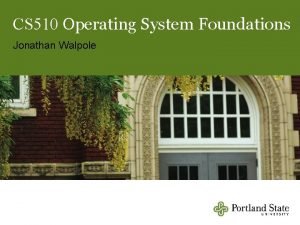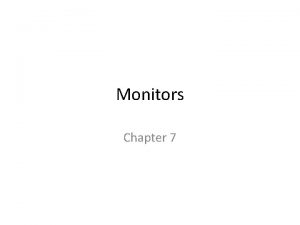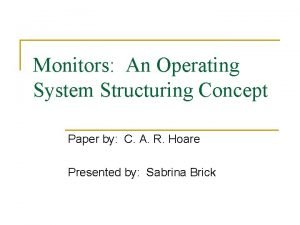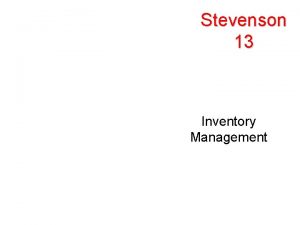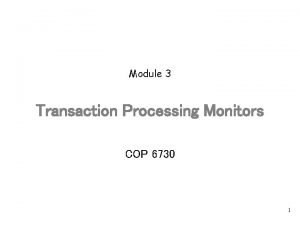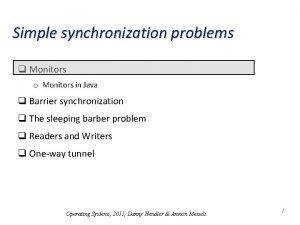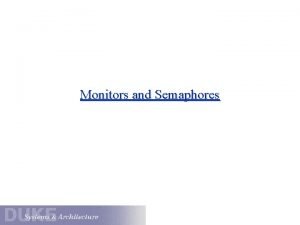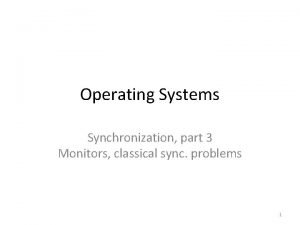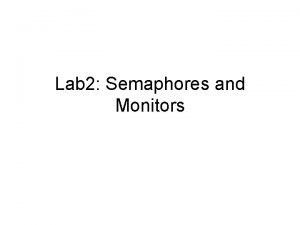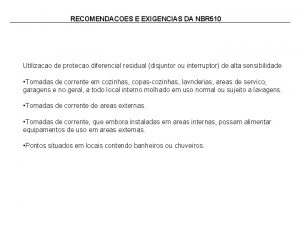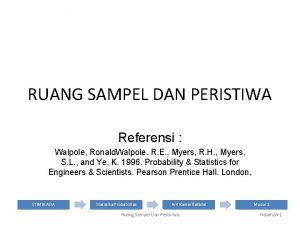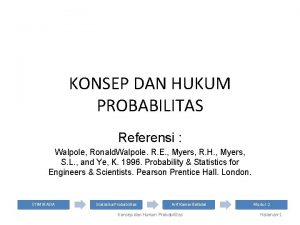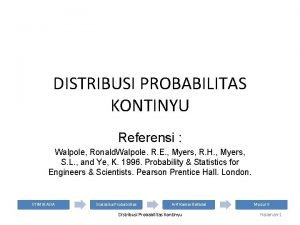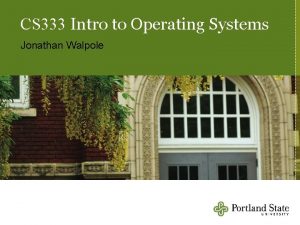CS 510 Operating System Foundations Jonathan Walpole Monitors





















![Example Use of Hoare Semantics monitor Bounded. Buffer var buffer: array[n] of char next. Example Use of Hoare Semantics monitor Bounded. Buffer var buffer: array[n] of char next.](https://slidetodoc.com/presentation_image/e9f28d45ed0293b23b47ba7e80aff8b6/image-22.jpg)
![Example Use of Mesa Semantics monitor Bounded. Buffer var buffer: array[n] of char next. Example Use of Mesa Semantics monitor Bounded. Buffer var buffer: array[n] of char next.](https://slidetodoc.com/presentation_image/e9f28d45ed0293b23b47ba7e80aff8b6/image-23.jpg)
![Example Use of Hoare Semantics monitor Bounded. Buffer var buffer: array[n] of char next. Example Use of Hoare Semantics monitor Bounded. Buffer var buffer: array[n] of char next.](https://slidetodoc.com/presentation_image/e9f28d45ed0293b23b47ba7e80aff8b6/image-24.jpg)
![Example Use of Mesa Semantics monitor Bounded. Buffer var buffer: array[n] of char next. Example Use of Mesa Semantics monitor Bounded. Buffer var buffer: array[n] of char next.](https://slidetodoc.com/presentation_image/e9f28d45ed0293b23b47ba7e80aff8b6/image-25.jpg)


- Slides: 27

CS 510 Operating System Foundations Jonathan Walpole

Monitors 2

Programming Complexity There are many ways to introduce bugs using locks and semaphores - forget to lock somewhere in the program - forget to unlock - maybe in an error path or conditional - non-unique association between data and locks reuse of global value copied to a local initialize lock or semaphore to wrong value incorrect ordering of down and up 3

Can The Compiler Help? If the set of locking rules is well-defined, why can’t the compiler generate the correct synchronization code for us? We need high level language abstractions for concurrency 4

Monitors Related shared/global variables are grouped together and protected by the same lock Encapsulation and mutual exclusion can be enforced by the compiler or by programming convention - Encapsulation Local data variables are accessible only via the monitor’s “entry procedures” (i. e. , external methods) - Mutual exclusion Threads must acquire the monitor’s mutex lock before invoking one of its procedures 5

Mutual Exclusion in Monitors A monitor consists of its data and the methods that access it Each monitor has a mutex lock associated with it, called the monitor’s mutex The monitor’s mutex is acquired at the start of every monitor method and released at the end Only one thread is active in the monitor at any time! 6

Condition Variables What if a thread needs to wait during its computation? - maybe it can’t proceed until one of the monitor’s variables reaches a certain value - i. e. , producer can’t proceed if buffer is full - another thread must run in the monitor while this one waits, so it must give up the mutex! How will this thread wake up? 7

Condition Variables Condition variables (cv) for use within monitors cv. wait() - Caller thread is blocked It is enqueued on this variable’s waiting threads list It must not block while holding the monitor’s mutex! The monitor’s mutex must be released in wait, so another thread can access the monitor’s data - cv. signal() - Dequeues the thread at the head of the waiting list - Unblocks it and places it on the ready list 8

Condition Variables vs Semaphores Condition variables look like semaphores The key difference: - condition variables do not have an integer value a wait always causes the thread to block a signal only wakes up a thread if one is waiting a signal that occurs when no threads are waiting is lost! Consider the implications of this for the Dining Philosopher’s solution in assignment 2!

Overview of Monitor Structure monitor’s shared data condition variables (these are also shared monitor variables!) Each condition variable has an associated list of waiting threads monitor entry queue x y “entry” methods local methods initialization code List of threads waiting to enter the monitor Can be called from outside the monitor. Only one active at any moment. 10

Compiler Support for Monitors If monitors are part of the programming language, the compiler can generate the monitor lock and unlock code automatically - programmer may simply define the type of a data item to be monitor (or synchronized) - the monitor mutex to be released in wait is identified implicitly by the condition variable’s monitor If monitors are unknown to the compiler (as in Blitz), the programmer writes the monitor mutex code - wait takes the monitor mutex as a parameter 11

Producer-Consumer with Monitors process Producer begin loop <produce char “c”> Bounded. Buffer. deposit(c) end loop end Producer� process Consumer begin loop Bounded. Buffer. remove(c) <consume char “c”> end loop end Consumer monitor: Bounded. Buffer var buffer : . . . ; next. In, next. Out : . . . ; entry deposit(c: char) begin. . . end entry remove(var c: char) begin. . . end Bounded. Buffer 12

Use of Condition Variables monitor : Bounded. Buffer var buffer : next. In, next. Out : full. Count : not. Empty, not. Full : array[0. . n-1] of char 0. . n-1 : = 0 0. . n : = 0 condition entry deposit(c: char) begin if (full. Count = n) then wait(not. Full) end if buffer[next. In] : = c next. In : = next. In+1 mod n full. Count : = full. Count+1 signal(not. Empty) end deposit entry remove(var c: char) begin if (full. Count = n) then wait(not. Empty) end if c : = buffer[next. Out] next. Out : = next. Out+1 mod n full. Count : = full. Count-1 signal(not. Full) end remove end Bounded. Buffer 13

Observations In this example, monitor types are part of the programming language The compiler is enforcing mutual exclusion among accesses to a monitor type - the monitor mutex lock and unlock operations are not visible in the source code - the monitor lock is not passed as a parameter to wait 14

Condition Variables in Blitz Monitors are not known to the KPL compiler in Blitz! Condition class is used to implement monitors - Condition. wait (mutex) - Condition. signal (mutex) - Condition. broadcast(mutex) Mutex must be passed to condition methods to indicate which monitor the condition is in Mutex lock/unlock code must be written by the programmer on entry/exit to/from monitor methods

Condition Variable Semantics Mutual exclusion requirement: - Only one thread at a time can execute in the monitor Scenario: - Thread A is executing in the monitor Thread A does a signal waking up thread B Which thread runs in the monitor next? A and B must run in some order Which one runs, which one blocks, and how (on what queue)? 16

Option 1: Hoare Semantics What happens when A signals B? - A is suspended (added to waiting thread list for monitor mutex) - B wakes up and runs immediately (i. e. , nothing else runs in the monitor between the signal and the wakeup of B) - A hands B the monitor mutex directly A can only run when B leaves the monitor on exit or in another wait - A only resumes immediately if it is at the head of the mutex list - If not, other threads run before it 17

Memory Invariance under Hoare Semantics When B wakes up, the state of the monitor’s variables are the same as when A issued the signal When A resumes after signal, the state of the monitor’s variables may have changed! Implications: - Memory invariance is lost across wait - Memory invariance is lost across signal - Memory invariance is preserved across signal to wakeup from wait 18

Option 2: MESA Semantics What happens when A signals B? - A continues executing in the monitor - B tries to lock the monitor mutex, and takes its place at the back of the list - B resumes when its turn comes around 19

Memory Invariance under MESA Semantics When B wakes up, the state of the monitor’s variables may not be the same as when A issued the signal! - the signal is more like a hint - the waking thread must check to see if it should continue or wait again When A continues after signal, the state of the monitor’s variables have not changed, because A retained the mutex Implications: 20

Memory Invariance under MESA Semantics Implications: - Memory invariance is lost across wait - Memory invariance is not lost across signal - Memory invariance is not preserved across signal to wakeup from wait The different implications for memory invariance affect how you write code that uses condition variables You really need to know the semantics of your condition variables!!! 21
![Example Use of Hoare Semantics monitor Bounded Buffer var buffer arrayn of char next Example Use of Hoare Semantics monitor Bounded. Buffer var buffer: array[n] of char next.](https://slidetodoc.com/presentation_image/e9f28d45ed0293b23b47ba7e80aff8b6/image-22.jpg)
Example Use of Hoare Semantics monitor Bounded. Buffer var buffer: array[n] of char next. In, next. Out: int = 0 cnt. Full: int = 0 not. Empty: Condition not. Full: Condition entry deposit(c: char) if cnt. Full == N not. Full. Wait() end. If buffer[next. In] = c next. In = (next. In+1) mod N cnt. Full = cnt. Full + 1 not. Empty. Signal() end. Entry Hoare Semantics entry remove(). . . end. Monitor 22
![Example Use of Mesa Semantics monitor Bounded Buffer var buffer arrayn of char next Example Use of Mesa Semantics monitor Bounded. Buffer var buffer: array[n] of char next.](https://slidetodoc.com/presentation_image/e9f28d45ed0293b23b47ba7e80aff8b6/image-23.jpg)
Example Use of Mesa Semantics monitor Bounded. Buffer var buffer: array[n] of char next. In, next. Out: int = 0 cnt. Full: int = 0 not. Empty: Condition not. Full: Condition entry deposit(c: char) while cnt. Full == N not. Full. Wait() end. While buffer[next. In] = c next. In = (next. In+1) mod N cnt. Full = cnt. Full + 1 not. Empty. Signal() end. Entry MESA Semantics entry remove(). . . end. Monitor 23
![Example Use of Hoare Semantics monitor Bounded Buffer var buffer arrayn of char next Example Use of Hoare Semantics monitor Bounded. Buffer var buffer: array[n] of char next.](https://slidetodoc.com/presentation_image/e9f28d45ed0293b23b47ba7e80aff8b6/image-24.jpg)
Example Use of Hoare Semantics monitor Bounded. Buffer var buffer: array[n] of char next. In, next. Out: int = 0 cnt. Full: int = 0 not. Empty: Condition not. Full: Condition entry deposit(c: char). . . entry remove() if cnt. Full == 0 not. Empty. Wait() end. If c = buffer[next. Out] next. Out = (next. Out+1) mod N cnt. Full = cnt. Full - 1 not. Full. Signal() end. Entry Hoare Semantics end. Monitor 24
![Example Use of Mesa Semantics monitor Bounded Buffer var buffer arrayn of char next Example Use of Mesa Semantics monitor Bounded. Buffer var buffer: array[n] of char next.](https://slidetodoc.com/presentation_image/e9f28d45ed0293b23b47ba7e80aff8b6/image-25.jpg)
Example Use of Mesa Semantics monitor Bounded. Buffer var buffer: array[n] of char next. In, next. Out: int = 0 cnt. Full: int = 0 not. Empty: Condition not. Full: Condition entry deposit(c: char). . . entry remove() while cnt. Full == 0 not. Empty. Wait() end. While c = buffer[next. Out] next. Out = (next. Out+1) mod N cnt. Full = cnt. Full - 1 not. Full. Signal() end. Entry MESA Semantics end. Monitor 25

Monitors in Blitz They have MESA semantics - When a waiting thread resumes, you can’t assume that the state of the monitor’s variables is the same as when signal was called! There is a broadcast call in addition to signal - broadcast wakes up all threads waiting on the condition variable - broadcast makes no sense for condition variables with Hoare semantics! 26

Implementing Hoare Semantics In Assignment 4 you must modify Blitz condition variables to have Hoare semantics: - Do not modify the mutex methods provided, because future code will use them - Create new classes: Monitor. Lock -- similar to Mutex Hoare. Condition -- similar to Condition You must write your own test code! 27
 Jonathan walpole
Jonathan walpole Jonathan walpole
Jonathan walpole Drawbacks of semaphore
Drawbacks of semaphore Monitors in os
Monitors in os Iht heart rate monitors
Iht heart rate monitors Objectives of eoq
Objectives of eoq Patient bedside monitors
Patient bedside monitors Hand held computer
Hand held computer Which organization monitors interstate fish shipments?
Which organization monitors interstate fish shipments? Energy star monitors
Energy star monitors What are monitors and condition variables?
What are monitors and condition variables? Transaction processing monitors
Transaction processing monitors Dining philosophers problem using monitors java
Dining philosophers problem using monitors java Identifies, selects, monitors, and evaluates sales channels
Identifies, selects, monitors, and evaluates sales channels Sleeping barber problem using monitors
Sleeping barber problem using monitors Citra two monitors
Citra two monitors Intervax bcg
Intervax bcg Mesa semantics
Mesa semantics Food & beverage gas safety monitors
Food & beverage gas safety monitors Sleeping barber problem using monitors
Sleeping barber problem using monitors Semaphores and monitors
Semaphores and monitors Buddy system operating system
Buddy system operating system File system in operating system
File system in operating system File system in operating system
File system in operating system File system in operating system
File system in operating system Nbr 510
Nbr 510 (753 a. de c.-510 a. de c.)
(753 a. de c.-510 a. de c.) Toefl itp 590
Toefl itp 590

